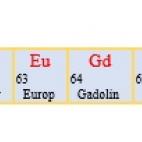In today's world of rapidly developing technologies, a particular group of seventeen chemical elements is becoming increasingly important technologically, and thus economically. They are unique both because of their properties and their rarity in the earth's crust. These are the so-called rare earth metals.
Rare earth metals have similar physical and chemical characteristics, which is why they have been classified in the common third group in the periodic table of elements. Two sub-groups were identified. The one that starts with lanthanum (hence its name 'lanthanides') contains 15 elements: lanthanum, cerium, praseodymium, neodymium, promethium, samarium, europium, gadolinium, terbium, dysprosium, holmium, erbium, thulium, ytterbium and lutetium. The second includes two elements - the 'scandiums' - scandium and yttrium. All of these elements occur as silvery metals. Their designation as 'rare' is linked to their wide dispersion in the earth's crust, which makes them difficult to obtain.
The following are examples of applications of selected rare earth elements:
- cerium, lutetium, praseodymium, neodymium, gadolinium, erbium, holmium - are used in ceramics, heat-resistant glasses, car glasses, dyes, fuel cells, superconductors;
- praseodymium, neodymium, samarium, terbium, dysprosium, holmium - used for the production of magnets installed in electric motors, generators, loudspeakers, microphones, medical apparatus;
- europium, yttrium, terbium, neodymium, erbium, gadolinium, cerium, praseodymium - are used in the manufacture of screens, light emitting diodes (LEDs), lasers, touch screens, optical fibres;
- lanthanum, cerium, praseodymium, neodymium - are included in automotive catalysts and are used in oil refining;
- promethium - is used as a source of beta radiation;
- scandium, yttrium, cerium - are components of metal alloys.
The best illustration of the very important role that rare earths play in the production of everyday devices is the smartphone - praseodymium, neodymium, yttrium, lanthanum, europium, terbium, gadolinium and dysprosium are used to build its components.
It can be seen that almost all high-tech industries depend on access to rare earth elements. This brings with it high prices for these desirable materials.






